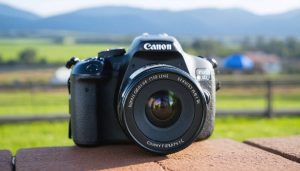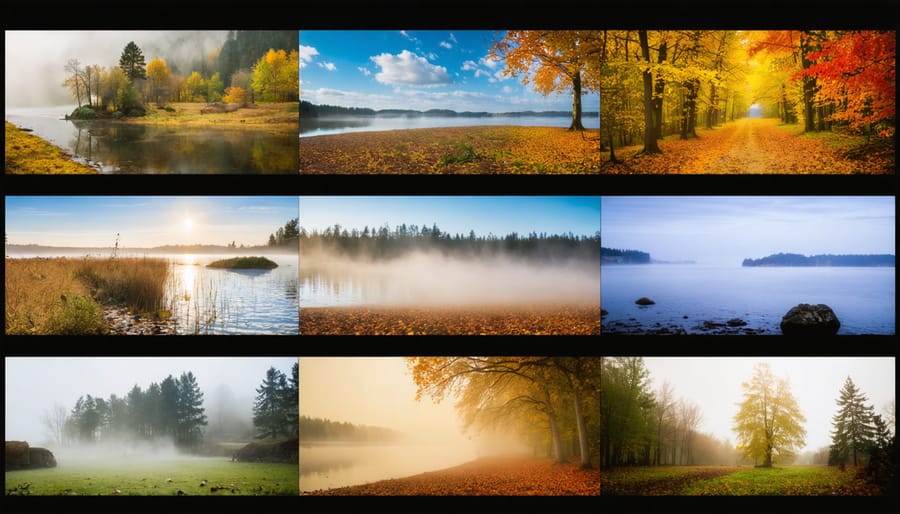
A landscape photography portfolio captures more than just beautiful vistas – it reveals your unique artistic vision and technical mastery of light, composition, and timing. Curating a compelling collection requires ruthless editing, selecting only those images that evoke genuine emotional responses while demonstrating diverse skills across different conditions and locations.
Start with your absolute best 15-20 images, each telling its own story while contributing to a cohesive narrative throughout your portfolio. Consider how each photograph flows into the next, creating visual rhythm through complementary colors, contrasting moods, and varying scales – from intimate details to grand panoramic views.
Your portfolio should showcase technical excellence in fundamental areas: sharp focus, thoughtful composition, masterful exposure control, and skillful post-processing that enhances rather than overwhelms. Include work photographed during different seasons, weather conditions, and times of day to demonstrate versatility. Each image should stand alone as a testament to your ability while fitting seamlessly into your broader artistic vision.
Whether presenting online or in print, maintain consistent quality and style throughout. A professional portfolio isn’t just a collection of pretty pictures – it’s a powerful marketing tool that opens doors to exhibitions, publications, and commissioned work while establishing your unique voice in landscape photography.
Essential Elements of a Compelling Landscape Portfolio
Diversity in Compositions
A strong landscape photography portfolio should showcase your versatility through diverse compositional approaches. While the classic wide-angle vista is essential, incorporating varying perspectives adds depth and demonstrates your creative range. Consider including intimate landscapes that focus on patterns and textures, vertical compositions that emphasize height and scale, and abstract interpretations that challenge traditional landscape conventions.
Mix leading lines, rule of thirds, and symmetrical compositions to display your technical expertise. Include both minimalist scenes that embrace negative space and complex compositions that layer multiple elements. Don’t shy away from including dramatic perspectives like bird’s-eye views or ground-level shots that offer unique viewpoints of familiar landscapes.
Balance your portfolio with different focal lengths too. While wide-angle shots capture sweeping scenes, telephoto compositions can isolate compelling details or compress distant elements for dramatic effect. Including both grand vistas and smaller scenes shows your ability to find beauty at every scale.
Remember to showcase different atmospheric conditions – from moody fog to dramatic storms – as this demonstrates your adaptability and commitment to capturing landscapes in various conditions.
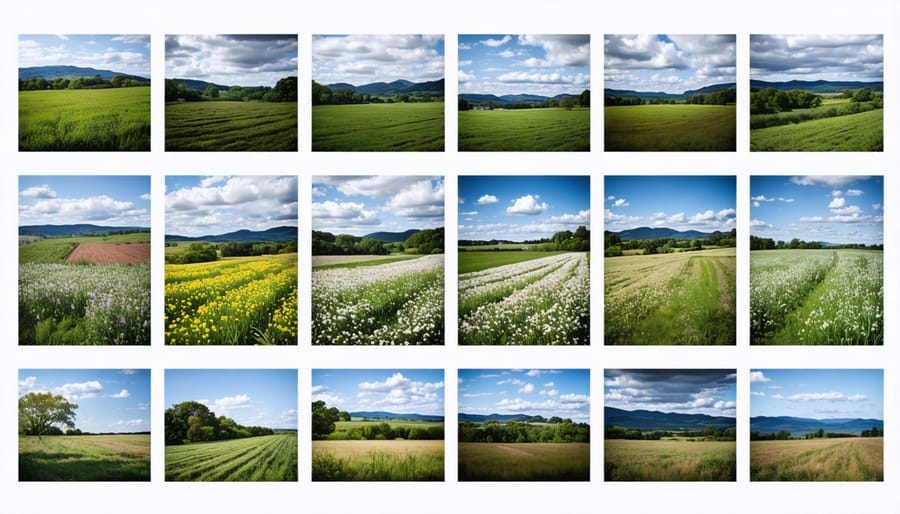
Seasonal Variety
A compelling landscape photography portfolio should showcase your ability to capture nature’s ever-changing moods through different seasons. Winter’s stark minimalism, spring’s vibrant renewal, summer’s golden hours, and autumn’s fiery displays each offer unique opportunities to demonstrate your versatility as a photographer.
Consider including at least one strong image from each season to illustrate your adaptability to varying lighting conditions and weather patterns. Winter scenes with frost-covered branches or misty mornings can convey serenity, while autumn landscapes bursting with color demonstrate your eye for dramatic natural compositions. Spring’s soft morning light and summer’s dramatic storm clouds provide contrasting elements that keep your portfolio dynamic and engaging.
Beyond seasons, showcase your mastery of different lighting conditions. Include examples of golden hour warmth, blue hour subtlety, and even challenging midday shots. This variety not only displays technical proficiency but also shows potential clients your ability to create compelling images regardless of conditions. Remember, locations photographed across different seasons can tell powerful stories about the passage of time and your commitment to revisiting and reimagining familiar scenes.
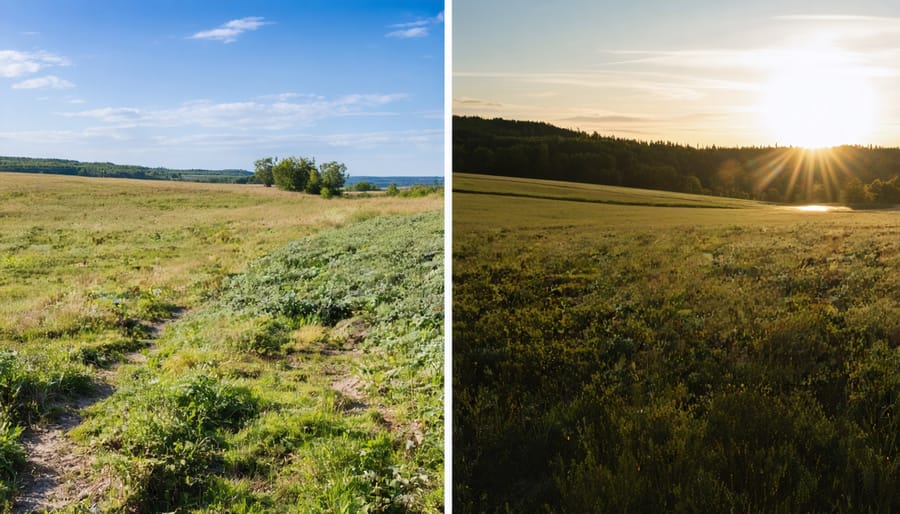
Technical Excellence
Technical excellence is the cornerstone of a compelling landscape photography portfolio. Every image should showcase pristine sharpness from foreground to background, with particular attention to detail in both highlight and shadow areas. Aim for optimal exposure across your collection, ensuring consistent processing that maintains natural colors while enhancing the scene’s drama.
Focus on delivering tack-sharp images through proper focusing techniques and appropriate aperture selection. Your portfolio should demonstrate mastery of dynamic range management, showing well-balanced exposures that retain detail in both bright skies and darker terrain. Post-processing should be refined yet subtle, maintaining a cohesive look across your entire collection without appearing over-edited.
Pay special attention to the technical aspects that matter most in landscape work: clean sensor spots, straight horizons, and minimal noise in shadow areas. While each image should stand alone in technical quality, the entire portfolio should maintain a consistent standard of excellence that reflects your professional approach to the craft.
Curating Your Collection
Quality Over Quantity
When building your landscape photography portfolio, remember that a smaller collection of exceptional images will make a stronger impression than a large array of mediocre ones. Start by selecting 15-20 of your absolute best photographs that truly represent your style and technical ability.
Consider each image’s emotional impact and technical execution. Does it evoke a sense of place? Is the composition strong? Are the exposure and focus precise? Be brutally honest with yourself during this process. If you’re unsure about an image, it probably shouldn’t make the cut.
Ask yourself these key questions for each photograph:
– Does it demonstrate your unique perspective?
– Is the technical quality outstanding?
– Would you proudly display it as a large print?
– Does it complement your other selected images?
– Has it received positive feedback from peers or clients?
Seek input from fellow photographers or mentors you trust, but don’t let their opinions override your artistic vision. Remember that your portfolio should tell a cohesive story while showcasing various conditions, seasons, and techniques within your landscape work.
Consider creating themed collections within your portfolio: mountain landscapes, seascapes, or golden hour shots. This organization helps viewers understand your specialties while maintaining a strong narrative thread throughout your presentation.
Finally, regularly review and update your selection. As your skills evolve, some images that once seemed portfolio-worthy may no longer meet your standards. Keep raising the bar for what you consider portfolio-worthy work.
Creating Visual Flow
Creating a visual flow in your landscape photography portfolio is like composing a symphony – each image should lead naturally to the next, creating a harmonious viewing experience. Start by arranging your images based on complementary colors or similar tonal qualities. For instance, pair sunset photos with similar warm-toned images, or group moody, dark mountainscapes together.
Consider the visual weight of each image when arranging your portfolio. Place stronger, more dramatic images at key points – typically the beginning, middle, and end of your sequence. This creates natural peaks of interest that keep viewers engaged. Transition between these focal points using images that share visual elements, like leading lines or recurring shapes.
Pay attention to the directional flow within your images. If one photograph has strong lines leading to the right, follow it with an image that either continues that movement or provides a natural stopping point. This technique guides the viewer’s eye through your portfolio in a deliberate, meaningful way.
Don’t forget about emotional pacing. Alternate between grand, sweeping vistas and intimate landscape details to create rhythm and prevent visual fatigue. Mix horizontal and vertical compositions thoughtfully, but maintain consistency in your presentation style. Remember, your goal is to tell a cohesive story through your images, not just showcase individual beautiful shots.
Regular Updates and Maintenance
A dynamic landscape photography portfolio requires regular attention and updates to maintain its effectiveness. Aim to review your portfolio every three to four months, ensuring it reflects your current skill level and artistic vision. When updating, consider replacing older images with newer, technically superior ones that demonstrate your evolution as a photographer.
Create a systematic approach to portfolio maintenance by maintaining a collection of potential portfolio images throughout the year. As you capture new landscapes, tag or flag promising shots that might deserve a place in your showcase. This makes the update process more manageable and ensures you’re always ready to refresh your content.
Pay attention to seasonal variety in your portfolio. If you’ve captured stunning autumn scenes, consider updating your collection when winter arrives to showcase your versatility. This approach is particularly valuable when marketing your photography work to potential clients who may be interested in specific seasons.
Keep your portfolio relevant by responding to current trends in landscape photography while maintaining your unique style. Monitor feedback from clients and fellow photographers, and use analytics data from your online portfolio to understand which images resonate most with your audience. Remove images that no longer represent your best work or align with your artistic direction.
Remember to maintain consistent quality across all platforms where your portfolio appears, whether it’s your website, social media, or printed materials. Regular updates signal to potential clients that you’re active and committed to your craft.
Presentation Formats
Digital Platforms
In today’s digital age, choosing the right platform to showcase your landscape photography is crucial for reaching your target audience. Several excellent options cater specifically to photographers, each offering unique features and benefits for portfolio website development.
Squarespace stands out for its elegant, mobile-responsive templates and intuitive interface. Its drag-and-drop builder makes it easy to create stunning galleries, while built-in e-commerce features allow you to sell prints directly to clients. Adobe Portfolio, included with Creative Cloud subscriptions, seamlessly integrates with Lightroom and offers clean, professional layouts perfect for landscape photography.
Format caters specifically to visual artists, providing powerful gallery management tools and the ability to protect your images. Their specialized features include client proofing and built-in SEO tools to help your work get discovered. WordPress, while requiring more technical knowledge, offers unlimited customization possibilities through themes and plugins designed for photographers.
For those seeking simplicity, Smugmug provides unlimited photo storage, powerful privacy controls, and print fulfillment services. Their platform specializes in image protection and includes features for selling prints and digital downloads. Meanwhile, Behance offers excellent exposure within the creative community, making it an ideal secondary platform for networking and inspiration.
Consider factors like storage capacity, image protection, customization options, and pricing when choosing your platform. Many services offer free trials, so experiment with different options to find the one that best suits your needs and aesthetic preferences.
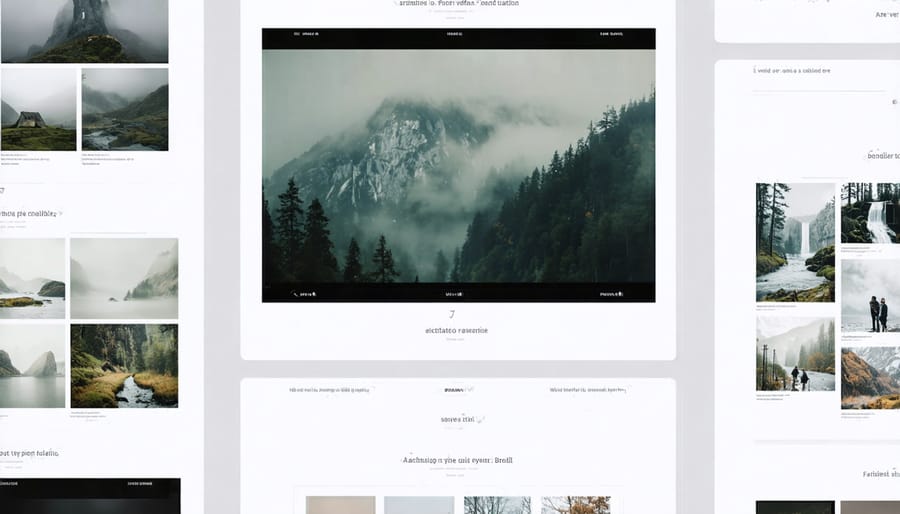
Print Collections
While digital portfolios dominate today’s photography landscape, physical print collections remain a powerful way to showcase your work. Creating effective print portfolios requires careful consideration of materials, presentation, and print quality.
Start by selecting a high-quality portfolio book with archival-grade paper. Look for options with acid-free pages that will preserve your images’ colors and prevent yellowing over time. Consider books with removable pages, allowing you to update your collection as your work evolves.
Print quality is paramount. Work with a professional lab that specializes in fine art printing, and always request test prints before committing to full-size prints. Pay special attention to color accuracy, contrast, and paper texture. Matte papers often work beautifully for landscape photography, offering rich blacks and minimal glare.
When designing your layout, maintain consistent spacing and arrange images to create a natural flow. Consider including brief captions with location details and technical information, but keep them minimal to let your images speak for themselves. A standard size for landscape portfolio prints is 11×14 inches, though larger formats can create more impact for certain images.
Protect your prints with archival sleeves or mounting them behind museum-grade glass. Handle prints wearing cotton gloves to prevent fingerprints and oils from damaging the surface. Store your portfolio in a climate-controlled environment away from direct sunlight to ensure its longevity.
Remember to include a brief artist statement and contact information, professionally printed on quality paper that matches your portfolio’s aesthetic. This personal touch can make your collection more memorable to potential clients or galleries.
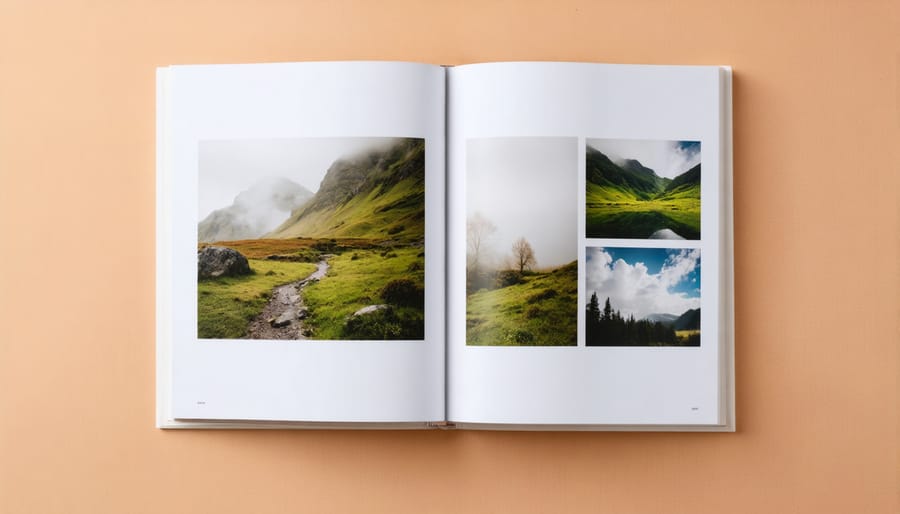
Social Media Integration
In today’s digital age, integrating your landscape photography portfolio with social media platforms is essential for maximizing visibility and engagement. While your main portfolio serves as your professional showcase, social media marketing can help you reach a broader audience and create meaningful connections within the photography community.
Instagram remains the premier platform for landscape photographers, with its visual-first approach and engaged photography community. Create a consistent posting schedule, use relevant hashtags, and maintain a cohesive aesthetic that reflects your portfolio’s style. Consider using Instagram Stories and Reels to share behind-the-scenes content and photography tips.
LinkedIn is excellent for connecting with potential clients and other professionals. Share your work alongside insights about your creative process or technical approach to demonstrate expertise. Facebook Groups can help you join communities of fellow landscape photographers, while Pinterest’s long-lasting content can drive traffic to your main portfolio.
Remember to cross-post strategically rather than sharing identical content across all platforms. Each platform has its unique audience and requirements. For instance, vertical images work better on Pinterest, while Instagram favors square or 4:5 ratio images. Always include links to your main portfolio in your social media profiles, and consider using a link-in-bio tool to direct followers to your latest work or featured collections.
Portfolio Optimization
Image Resolution and Format
Image resolution and format choices can make or break your landscape photography portfolio, whether you’re showcasing your work online or in print. For web display, export your images at 72-100 DPI, keeping file sizes manageable while maintaining quality. A width of 2000-2500 pixels typically works well for most online platforms, ensuring your images load quickly without compromising detail.
When preparing for print, aim for 300 DPI at your desired output size. If you’re creating a physical portfolio book, consider going even higher to 360 DPI for ultra-sharp results. Always save your master files in RAW format, then create separate versions optimized for different uses.
For web portfolios, JPEG format with 80-85% quality offers an excellent balance between file size and image quality. Consider using WebP format for websites, as it provides superior compression while maintaining clarity. For print portfolios, save your files as uncompressed TIFF or high-quality JPEG formats to preserve every detail.
Color space matters too – use sRGB for web display to ensure consistent colors across different devices and browsers. For print, Adobe RGB or ProPhoto RGB provide wider color gamuts, essential for accurate reproduction in high-quality photo books or exhibition prints. Always embed color profiles in your files to maintain color accuracy across different viewing platforms.
Remember to maintain backup copies of your high-resolution master files. Storage is relatively inexpensive, and you’ll never regret having the highest quality version available for future use.
Metadata and Keywords
Proper metadata and keywords are the invisible workhorses behind a successful landscape photography portfolio. Think of them as digital signposts that help your work get discovered by the right audience. When uploading your landscape images, take time to craft detailed, descriptive titles that go beyond simple location names. Instead of “Mountain Sunset,” try “Misty Sunrise Over Mount Rainier, Washington – Autumn 2023.”
Keywords should be both specific and strategic, incorporating elements like location, season, lighting conditions, and prominent features. Include common search terms like “landscape photography,” “nature photography,” but also specific details like “alpine lake,” “coastal sunset,” or “rolling hills.” This careful tagging helps optimize your social presence and improves visibility across various platforms.
Don’t forget to add comprehensive image descriptions that include technical details (camera settings, equipment used) and the story behind the shot. This metadata not only helps with SEO but also makes your portfolio more accessible to visually impaired visitors. Consider including GPS coordinates for location-specific shots, but be mindful of sensitive or protected areas where you might want to keep location details private.
Remember to maintain consistency in your naming conventions and keyword structure across your entire portfolio. This organized approach will make it easier to manage your collection as it grows while ensuring your work reaches its intended audience.
Creating a compelling landscape photography portfolio is a journey that requires careful thought, dedication, and artistic vision. By now, you understand the importance of curating your best work, organizing it effectively, and presenting it in a way that captivates your audience. Remember that your portfolio is more than just a collection of beautiful images – it’s a reflection of your unique perspective and technical expertise in capturing the natural world.
Whether you choose to showcase your work through a professional website, printed album, or both, focus on quality over quantity. Let each image tell its own story while contributing to your overall narrative as a landscape photographer. Keep your portfolio dynamic by regularly reviewing and updating it with your latest and best work, ensuring it remains fresh and relevant.
Don’t forget that successful portfolio presentation goes beyond just the images themselves. Consider how your work is displayed, the sequence of photos, and the overall user experience. Pay attention to the technical details of image preparation, whether that’s proper color calibration for digital displays or print specifications for physical portfolios.
Most importantly, start building your portfolio today. Don’t wait for the “perfect” collection – your portfolio will evolve as your skills grow. Share your work with fellow photographers, seek constructive feedback, and continue refining your selection. Your landscape photography portfolio is a living document of your artistic journey, and taking that first step is crucial to your growth as a photographer.

















